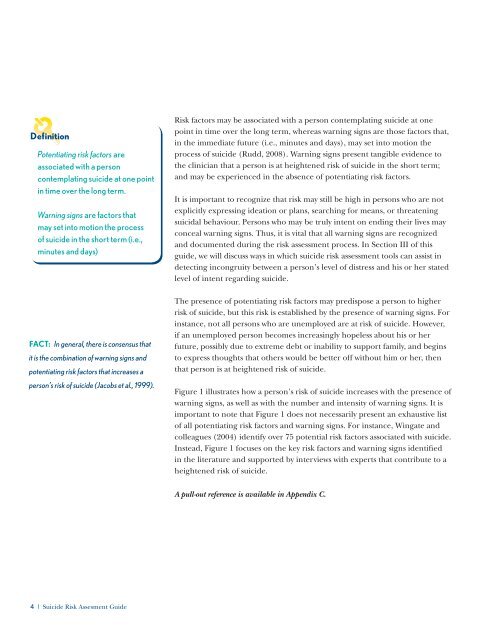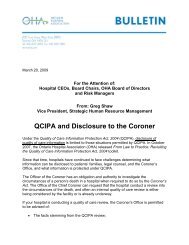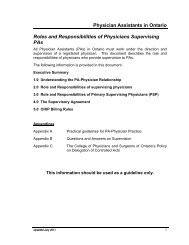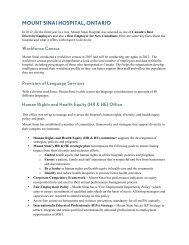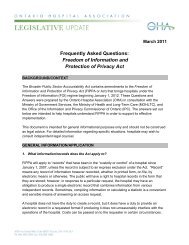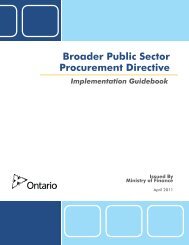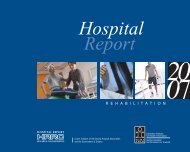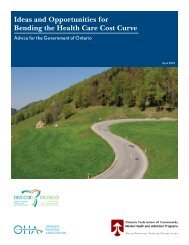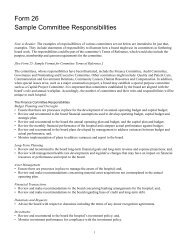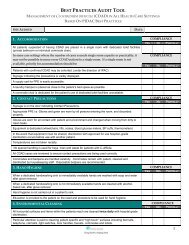Suicide Risk Assessment Guide - Ontario Hospital Association
Suicide Risk Assessment Guide - Ontario Hospital Association
Suicide Risk Assessment Guide - Ontario Hospital Association
Create successful ePaper yourself
Turn your PDF publications into a flip-book with our unique Google optimized e-Paper software.
Definition<br />
Potentiating risk factors are<br />
associated with a person<br />
contemplating suicide at one point<br />
in time over the long term.<br />
Warning signs are factors that<br />
may set into motion the process<br />
of suicide in the short term (i.e.,<br />
minutes and days)<br />
Fact: In general, there is consensus that<br />
it is the combination of warning signs and<br />
potentiating risk factors that increases a<br />
person’s risk of suicide (Jacobs et al., 1999).<br />
4 I <strong>Suicide</strong> <strong>Risk</strong> Assesment <strong>Guide</strong><br />
<strong>Risk</strong> factors may be associated with a person contemplating suicide at one<br />
point in time over the long term, whereas warning signs are those factors that,<br />
in the immediate future (i.e., minutes and days), may set into motion the<br />
process of suicide (Rudd, 2008). Warning signs present tangible evidence to<br />
the clinician that a person is at heightened risk of suicide in the short term;<br />
and may be experienced in the absence of potentiating risk factors.<br />
It is important to recognize that risk may still be high in persons who are not<br />
explicitly expressing ideation or plans, searching for means, or threatening<br />
suicidal behaviour. Persons who may be truly intent on ending their lives may<br />
conceal warning signs. Thus, it is vital that all warning signs are recognized<br />
and documented during the risk assessment process. In Section III of this<br />
guide, we will discuss ways in which suicide risk assessment tools can assist in<br />
detecting incongruity between a person’s level of distress and his or her stated<br />
level of intent regarding suicide.<br />
The presence of potentiating risk factors may predispose a person to higher<br />
risk of suicide, but this risk is established by the presence of warning signs. For<br />
instance, not all persons who are unemployed are at risk of suicide. However,<br />
if an unemployed person becomes increasingly hopeless about his or her<br />
future, possibly due to extreme debt or inability to support family, and begins<br />
to express thoughts that others would be better off without him or her, then<br />
that person is at heightened risk of suicide.<br />
Figure 1 illustrates how a person’s risk of suicide increases with the presence of<br />
warning signs, as well as with the number and intensity of warning signs. It is<br />
important to note that Figure 1 does not necessarily present an exhaustive list<br />
of all potentiating risk factors and warning signs. For instance, Wingate and<br />
colleagues (2004) identify over 75 potential risk factors associated with suicide.<br />
Instead, Figure 1 focuses on the key risk factors and warning signs identified<br />
in the literature and supported by interviews with experts that contribute to a<br />
heightened risk of suicide.<br />
A pull-out reference is available in Appendix C.


